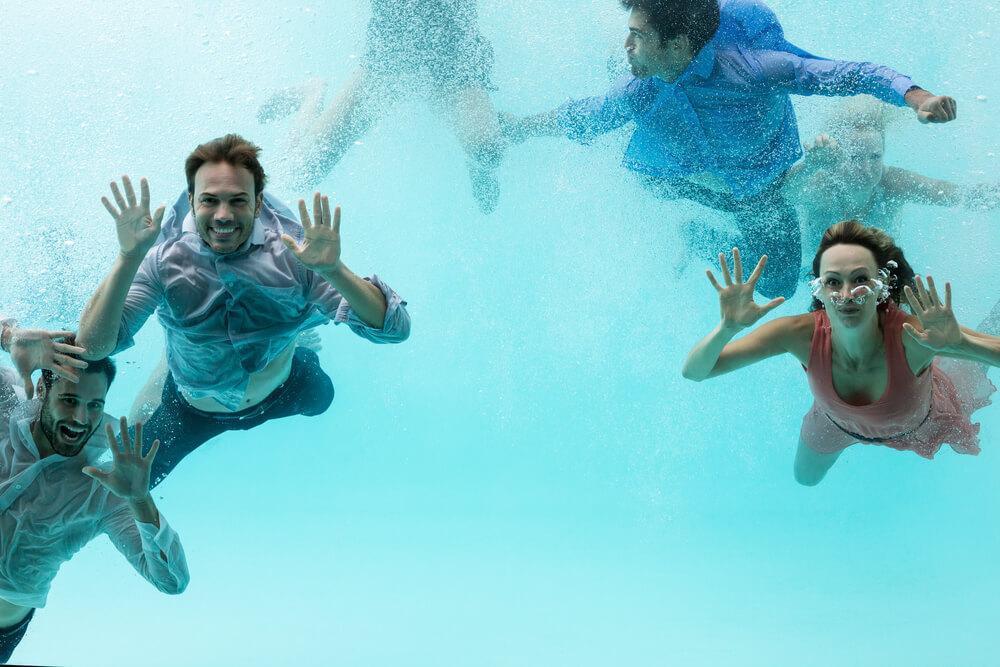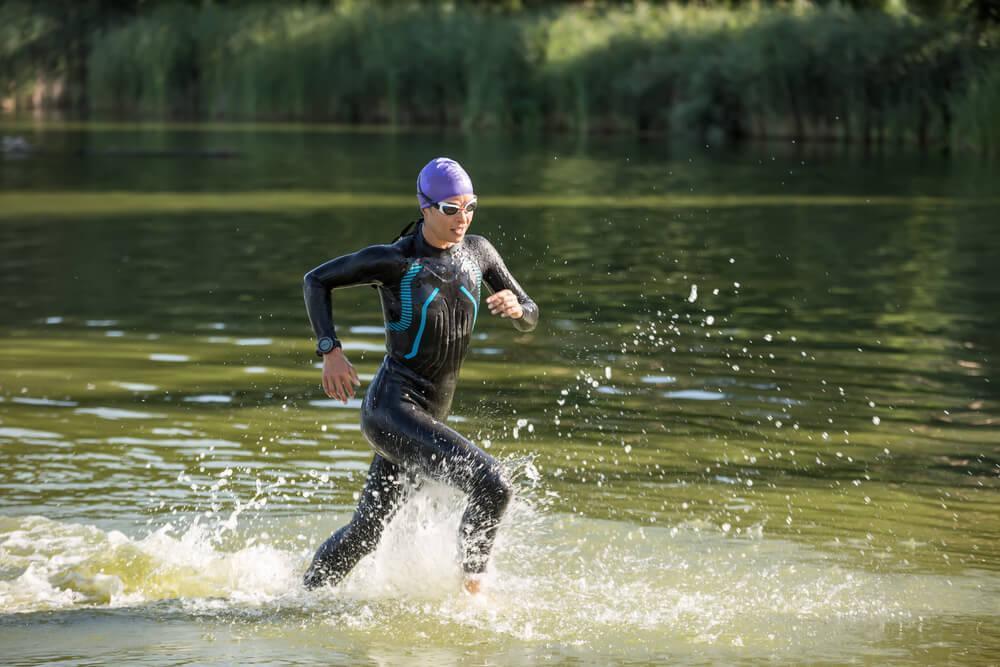
So, you’re looking for a way to improve your general fitness level and to challenge yourself while you’re at it?
Well, there’s nothing better than a good (not-so) old-fashioned Swimrun.
Although quite new, many have realized the incredible benefits Swimrun has for the body and for the mind. If you’re considering seeing what all the fuss is about, we highly recommend it!
What is Swimrun?
You may have heard about Swimrun, but aren’t quite sure what it is.
Well, have we got a surprise for you – it’s exactly what it says it is.
You swim.
And then you run.
Then repeat.
Sounds easy, right?
Well, a lot of things sound easy in general, until you test them out.
Swimrun is one of those things.
It falls into the category of endurance sports and it is quite strenuous.
However, endurance is something that is built, so if you’re a beginner, don’t be dissuaded from participating just because you have no prior experience.
As a sport, it is quite similar to aquathlon, but the switch between running and swimming happens several times throughout a single race. Another thing that is different is that you don’t change your gear. That’s it – you swim and you run with the same things you have on!
How Swimrun Came to Be

If we take into account its age, Swimrun would be considered a toddler compared to the majority of other sports.
No, not even a toddler – an infant.
The first organized event involving Swimrun took place as late as 2006, a mere 13 years ago!
It all started with a dare of four friends. It can’t get much better than that, now can it? They challenged each other to go across the Stockholm archipelago both by sea and on foot, from Utö to Sandhamn. It took them over 26 hours to actually complete the challenge.
Then, in 2006, the first ÖTILLÖ was held – the official competition in Swimrun.
Nowadays, there are various competitions organized throughout the world. All you need is a buddy – and sheer will power – and you’re good to go!
Benefits of Swimrun
So, you may be wondering – why should I decide to do such a challenging activity when I can swim and run separately?
Well, there are truly many benefits to such an activity, of course, when you’re prepared properly. In general, when you prepare for a Swimrun event, your body will go through extraordinary changes. You will build stamina and strength, and your body will be grateful for that both in the short and in the long run.
Here are some of the benefits of Swimrun:
- It burns more calories. Basically, with the change of activity, your body will spend more calories than if you were to just swim or run.
- You will get a rounded exercise. By both swimming and running, your body will go through a more rounded kind of workout, which will tone your legs, but also your torso.
- You will build your endurance. When you Swimrun, bit by bit, you build your endurance, and in the end, you will be able to work out for longer even if you switch to other types of exercises.
- Cool down time is simply divine. Basically, there’s nothing better than dipping in water after running. And, swimming is less hard on the body compared to running, so you’ll get some rest time before continuing with running.
How to Train for a Swimrun Event
Now, Swimrun being as exhausting as it is, you need to accommodate your training.
If you’re just starting with Swimrun, there are numerous workout plans for beginners.
But it all comes down to this – pace yourself, and don’t try to do too much too soon.
For a good general preparation in Swimrun, you will most likely need about two months. If you have more time, even better. Pacing yourself is of the utmost importance.
After the general preparation, you will need to dedicate yourself to your race specific preparation, which usually lasts for another 4-6 weeks.
And then, finally, just before the race, you will have to go through 2-3 weeks of reduced level of preparation for the race.
Start with the Basics
Some Swimrun events can be extremely challenging, with the running part being over 30 kilometers in certain races.
That is why it is really important that you get a good basis in running.

Start with several runs a week and aim for increasing the distance. This will be similar to amping up your cardio routine when you train at the gym. First, try to run for a longer time at a steady pace. Then try to incorporate one speed and one tempo session.
You should be able to build up to going on runs four times a week. Always mix distance, speed and terrain, for best results. When you are sufficiently comfortable with such a workout, choose one day and run twice. For instance, you could run 5 kilometers in the morning, and then another 5 kilometers later in the day. Start with two weeks of hard training, followed by one week in which you should go at an easier pace.
When it comes to swimming, you should also include several sessions each week. When you swim and run, try to do it as much as you can in your gear. For instance, if you plan to swim with paddles, you should wear them even when you go to swim at your local pool.
(Yes, we know, appearance-wise, it’ll probably look ridiculous, but training-wise, it will simply be – wise.)
Of course, first check with the pool officials whether they are fine with you practicing in full gear. They most likely won’t take kindly to your swimming in shoes, but a wetsuit is usually quite alright.
Again, when swimming, build your endurance and increase the distance you’re able to cross. Also, try to switch speed at which you swim (if possible). Three or four times a week in a pool is quite enough for a start.
Narrow it Down
At this stage, your preparation is meant to mimic the conditions you will endure during the race.
One of the key points in this phase is to use race gear into your workouts all the time. That means that you will have to swim with your shoes and run in your wetsuit. While that was not particularly important in the general preparation stage, now it is necessary to incorporate that.
In addition, if you plan to compete as a team, now you will have to do all of your workouts with your teammate, while you’re, preferably, tethered to them.
As you train, at this stage, you’re supposed to see how you will actually execute the race.
Now is a good time to make a decision about the gear you will use and how you will carry it while running. Also, you should see whether you might want to take your cap and goggles off when you run (they might fog when you transition from water to land and vice versa). If you decide to take them off, you need to check how you will carry them.
Another thing you should be doing now is seeing whether your sneakers and wetsuit are comfortable enough to run in them. Remember, you don’t want anything bothering you on the day of the race. If you’re having problems with either of those things, change them, and change them now. While all other parts of your gear are needed, good sneakers and a good wetsuit are pivotal.
You might want to work on your weak points, as well. So, if you’re having trouble with lack of strength in your arms, incorporate some exercises to counter that. If you’re having trouble with the strength in your legs, again, focus a bit on that.
Slow and Steady Wins the Race
As for the third stage of preparations, you will need to reduce (yes, you’ve read that correctly, you need to reduce) your exertion level.
Basically, by the time you reach this stage, you should have done everything to acclimatize your body to the conditions of the race. Now all you have to do is sustain the effort, which you can do with reduced-intensity workouts.
Even though this is important during the entire preparation, a week or two before the race is when you truly start preparing your body – but with proper diet and proper rest.
Eat well, sleep well and stay hydrated throughout the final weeks of your preparations.
The day before the race, it is good to mentally walk through it. Study maps of the area and try to see where the exit and entry points are, and if there are any particularly difficult trail sections.
If you have any questions about the trail, ask at the race meeting, and the race organizers will be more than happy to help you with your issues.
What Gear Do You Need?

This is where the difference between a triathlon and Swimrun is most prominent. When it comes to a triathlon, you are able to remove or add gear you need between disciplines.
You cannot do that with Swimrun.
You need to stay in the same gear both when running and when swimming.
Yeah, that brings us to possibly the worst part of Swimrun – running in soggy clothes.
But since in recent years, the popularity of the sport has only risen, some specialized pieces of equipment have already appeared, and it seems that the market will keep growing in the future.
This is what you will need to have if you plan to participate in a Swimrun event:
- A Swimrun wetsuit. This is, as you might have guessed, simply a must. It helps with both swimming and running in harsh conditions. However, since it is not always comfortable, there are special Swimrun wetsuits made, which are most likely your best bet if you are considering pursuing the sport in a serious way. Some athletes, who just do this recreationally, use a standard full-body wetsuit used for triathlons and simply cut the legs and sleeves off. This allows for more flexibility when you are running. However, if you’re considering doing this on a regular basis, it is advisable to get a real Swimrun wetsuit.
- Smeakers. Wetsuits are important, but so are sneakers. Whichever conditions you Swimrun in, you will need to choose lightweight ones – i.e. sneakers that will be able to drain water quickly. Footwear is important, since no one is keen on running in soggy shoes. Nowadays, there are quite a few options – there are sneakers specifically designed for such conditions and there are those with a mesh, which will also do the trick if professional gear is unavailable.
- Goggles. This is also a requirement for most Swimrun events. No matter the distance, no matter the course type, you will need goggles that fit you well and do not fog up. Let’s face it – you cannot run or swim if you cannot see. If you’ve miscalculated, it’s always good to have a spare pair that can fit both you and your partner.
- Buoys. There are basically two types of buoys that you may use in Swimrun events – a pull buoy and a tow buoy. The former is a piece of foam shaped as a figure eight. It is attached to your leg with an elastic band on the outer part of your leg. When you enter water, you put it between your legs and it helps the lower part of your body float. This, in turn, helps you focus on the arm stroke and helps you keep your leg energy for running parts of the race. When it comes to a tow/swim buoy, this is attached to you through a waistband. It is meant to drag behind you when you swim. Their purpose is mostly a safety one, as its bright color can help rescue workers find athletes better in the water.
- Paddles. Many athletes that compete in Swimrun use paddles. You are meant to hold them in your hand, as they help propel you when you swim. When you’re running, you can either flip them around to the back of your hand or simply remove them and tuck them into your wetsuit. Be mindful not to choose paddles that are too large or too small.






Leave A Comment